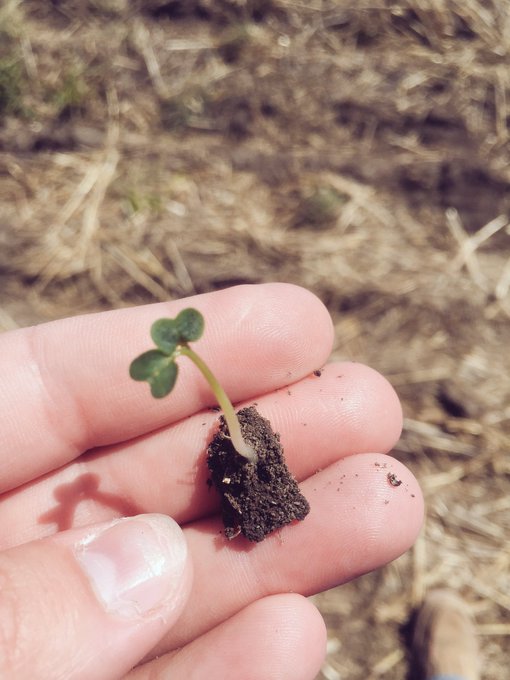Shallow seeding (0.5 to 1 inch) of canola into a firm, moist, warm seedbed helps ensure rapid, uniform germination with a high percentage of emergence. Deeply sown seeds require several days longer to emerge and may have reduced survival rates due to the insufficient stored energy in canola required to push cotyledons to the surface. However, in late May, if the soil is dry, seeding depth can be up to 1.5 inches, as warmer soil temperatures will help speed emergence.1 Consistent seeding depth so all seeds are placed into adequate soil moisture is the most critical step to ensure a uniform emergence. The small seed size can make it difficult for canola to push through crusted soils, so deeper seeding can result in reduced stands, especially in clay soils.
 Figure 1. Cotyledon stage canola, note length of hypocotyl, indicating about a 1-inch seeding depth. Image courtesy of Meghan Desjardins.
Figure 1. Cotyledon stage canola, note length of hypocotyl, indicating about a 1-inch seeding depth. Image courtesy of Meghan Desjardins.
If the seed is planted deeper than 1.5 inches, what are the possible negative impacts from seedling diseases?1
Soil temperature in the seed zone is lower at deeper seeding depths, which can reduce germination and slow emergence. Slower emergence can increase the risk of seeding diseases such as Fusarium, Pythium, and Rhizoctonia. Cool and wet conditions favor Fusarium and Pythium where cool and dry favor Rhizoctonia. Seed treatments help provide protection against these diseases, but the longer it takes for the seedling to emerge the more risk there is for infection. Other factors that can impact seedling diseases include soil compaction and short crop rotations with canola.
Does deeper seeding impact flea beetle injury to seedling canola?2
Indirectly. Hot and dry weather are the conditions that are most detrimental to seedling canola as it slows seedling growth, while flea beetle activity is increased. Systemic seed treatments provide protection against flea beetles for about 21 days after planting. Environmental conditions that slow canola growth can increase risk for feeding injury from flea beetles because uptake of systemic insecticide from the seed treatment is slowed.
If canola is planted deeper than 1.5 inches to reach moisture, are there practices that can be used to reduce the impact of a reduced stand?
As mentioned previously, seedling mortality can be higher with deeper plantings. Therefore, seeding deeper than recommended will often require a higher seeding rate to meet target plant stands, especially with added stress of dry conditions. If planting with a no-till drill, ensure that seed rows are not covered with previous crop residue to allow for quicker soil warm up.
How can the seeding depth be set in a small grain drill that is used to seed canola?3
Models may differ in their setup, but some planting depth adjustments are shared. On no-till drills, start adjusting the planting depth by adjusting the cutting depth of the rolling coulter. The coulter should be at twice depth of the planned seeding depth. The rolling coulter depth is usually adjusted by a knob or hydraulic setup. On some models, the stroke of the hydraulics that lift and lower the drill into the soil can be determined by blocks on the hydraulic cylinder. There are two other adjustments that are necessary on a no-till drill and similar adjustments are needed on conventional drill for seeding depth.
The depth of a double-disk opener is mostly determined by the down pressure of the drill weight and down pressure springs. There are usually one or two springs for each row unit that forces the opener down. Setting the springs to the lowest down pressure may be sufficient when the drill or springs are new. The springs may lose tension over time and may not provide enough down pressure. To create more down pressure, shorten the length of the spring’s travel according to the manufacturer’s instructions (usually by removing the “W” clip at the bottom of the spring and moving it to a higher hole in the rod that runs through the spring).
The press wheels need to be adjusted to provide the proper pressure to finalize seed depth. Many press wheels have a T-handle that can be adjusted forward (toward the tractor) allowing the depth to be shallower or backward (toward the press wheel) to enable a deeper seed placement. The press wheel adjustment operates in conjunction with the placement of the opener. Press wheels are designed to ensure that the openers are not pushed too deeply by the springs. The press wheels work in tandem with the springs. Properly adjusted press wheels assist when traveling rough seed bed there is enough flexibility in the travel of the springs, that the depth provide consistent depth. On some drills, depth bands can be added to the double-disk openers to ensure that the coulters penetrate to the precise depth desired.